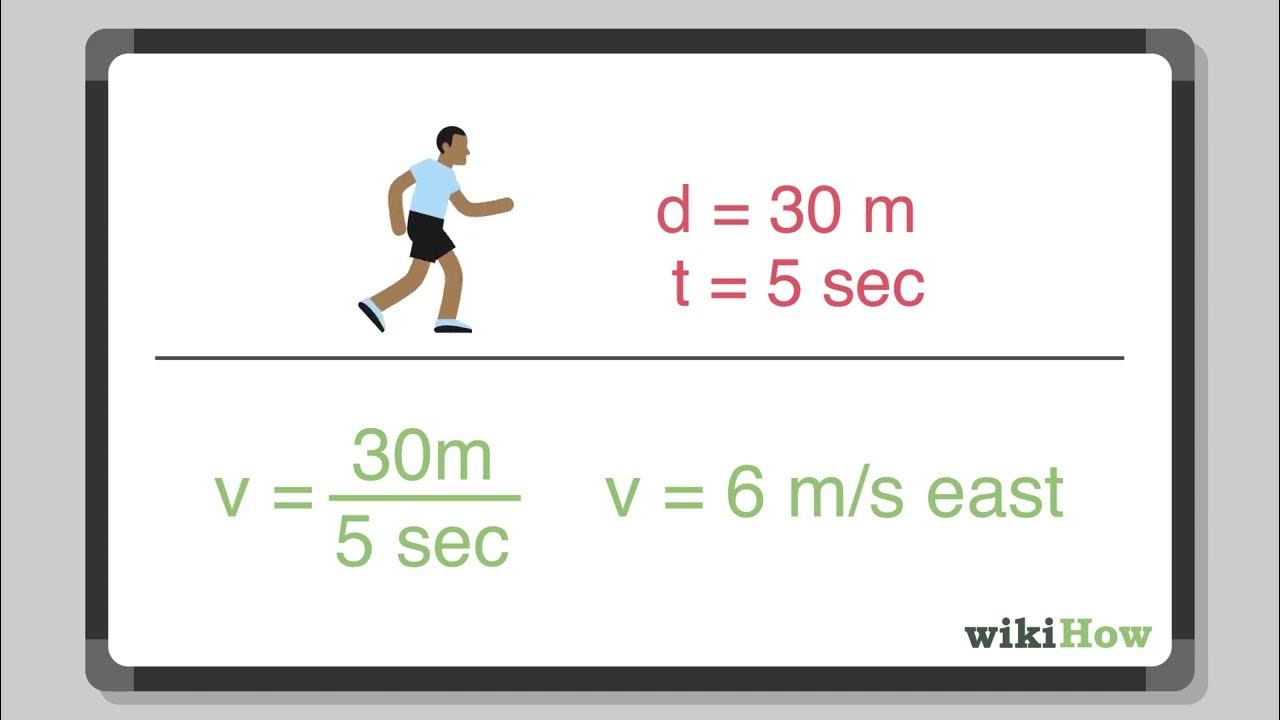High School Physics - Circular Speed
TLDRIn this informative video, Mr. Fullerton explains the concept of calculating the speed of an object moving in a circular path. He uses the average velocity formula and provides two detailed examples to illustrate the process. The first example involves Maranda driving around a 30-meter radius track, calculating her total distance, average speed, and centripetal acceleration. The second example determines the speed of a race car with a combined mass of 600 kg around a 160-meter radius track. The video effectively clarifies the principles with straightforward calculations, making it an engaging and educational resource.
Takeaways
- 📝 The main topic is calculating the speed of an object moving in a circular path.
- 🔄 To calculate speed, use the average velocity formula: V = distance traveled / time taken.
- 🌀 In circular motion, the distance is calculated as the number of revolutions times the circumference (2πR).
- 🚗 Example 1: Maranda drives her car around a circular track of radius 30 meters, completing 10 laps in 2 minutes.
- 🏁 Total distance for Example 1 is 10 laps * 2πR = 10 * 2π * 30 meters ≈ 1885 meters.
- 📊 Average speed for Example 1 is 1885 meters / 120 seconds ≈ 9.7 m/s (converting to MKS/SI units).
- 🔄 Centripetal acceleration is calculated as AC = V² / R.
- 🏎️ Example 2: A race car with a combined mass of 600 kg travels at a constant speed around a circular track of radius 160 meters in 36 seconds.
- 🏎️ Speed for Example 2 is one lap * 2πR / T = 2π * 160 meters / 36 seconds ≈ 27.9 m/s.
- 📈 The script provides a straightforward method for solving problems involving circular motion, including calculating distance, average speed, and centripetal acceleration.
Q & A
What is the main objective of the video?
-The main objective of the video is to explain how to calculate the speed of an object moving in a circular path, using average speed formula and centripetal acceleration concepts.
How is the average speed of an object in circular motion calculated?
-The average speed of an object in circular motion is calculated by dividing the total distance traveled by the time taken. The distance traveled is the number of revolutions multiplied by the circumference of the circle (2πR).
What is the formula for the circumference of a circle?
-The formula for the circumference of a circle is C = 2πR, where C is the circumference and R is the radius of the circle.
In the first example, how was the distance Maranda traveled calculated?
-Maranda's distance traveled was calculated by multiplying the number of laps (10) by the circumference of the track (2πR), where R is the radius of the track (30 meters).
What was Maranda's average speed in meters per second?
-Maranda's average speed was approximately 9.7 meters per second, calculated by dividing the total distance traveled (1885 meters) by the time taken (120 seconds).
What is the formula for centripetal acceleration?
-The formula for centripetal acceleration is ac = V^2 / R, where ac is the centripetal acceleration, V is the velocity of the object, and R is the radius of the circular path.
How was Maranda's centripetal acceleration calculated in the video?
-Maranda's centripetal acceleration was calculated by squaring her velocity (15.7 m/s) and dividing it by the radius of the track (30 meters), resulting in an acceleration of approximately 8.22 m/s^2.
What was the total distance the race car traveled in the second example?
-The race car traveled one lap around the circular track, which is equal to the circumference of the track (2πR). With a radius of 160 meters, the total distance was approximately 2π(160 meters) or 1004.8 meters.
What was the average speed of the race car?
-The average speed of the race car was approximately 27.9 meters per second, calculated by dividing the distance traveled (1004.8 meters) by the time taken (36 seconds).
How does the mass of the race car and driver affect the calculation?
-The combined mass of the race car and driver was given as 600 kilograms, but it was not used in the calculation of speed in this example. The mass would be relevant for calculating other quantities like centripetal force or kinetic energy.
Why is it important to convert time to seconds when calculating average speed?
-It is important to convert time to seconds when calculating average speed to ensure that the units are consistent with the standard SI (International System of Units). This allows for accurate comparison and calculation of speeds across different scenarios.
Outlines
📚 Introduction to Circular Motion Speed Calculation
This paragraph introduces the concept of calculating the speed of an object moving in a circular path. It explains the objective of using the average speed formula (V = distance/time) and how it applies to circular motion, taking into account the number of revolutions and the circumference of the circle (2πR). The paragraph sets the stage for solving example problems by illustrating the method to find the total distance traveled, average speed, and centripetal acceleration for an object in circular motion.
🚗 Maranda's Circular Track Drive
In this paragraph, the first example problem is presented where Maranda drives her car around a circular track with a radius of 30 meters, completing 10 laps in 2 minutes. The calculation of her total distance traveled is detailed, which is 10 times the circumference of the track (20πr), resulting in approximately 1885 meters. Her average speed is then determined as 9.7 meters per second by dividing the distance by the time (120 seconds). The paragraph also explains how to calculate centripetal acceleration (AC = V^2/R), resulting in approximately 8.22 meters per second squared for Maranda's drive.
🏎️ Racing Car's Lap Speed Analysis
The second example problem involves a race car with a combined mass of 600 kilograms and its driver, moving at a constant speed around a circular track with a radius of 160 meters in 36 seconds. The paragraph focuses on calculating the car's speed, using the average speed formula. The car's distance traveled is the track's circumference (2πr), leading to a speed of approximately 27.9 meters per second. This problem reinforces the application of the formula for circular motion speed calculation.
Mindmap
Keywords
💡Circular Path
💡Average Speed
💡Circumference
💡Revolution
💡Radius
💡Centripetal Acceleration
💡Velocity
💡Distance Traveled
💡Time
💡MKS or SI Units
💡Race Car
Highlights
The objective is to calculate the speed of an object moving in a circular path.
The average speed formula is used to determine the speed of an object in circular motion.
For circular motion, the distance is calculated based on the number of revolutions and the circumference of the circle (2πR).
An example is given where Maranda drives her car around a circular track with a radius of 30 meters, completing 10 laps in 2 minutes.
The total distance Maranda travels is calculated as 10 times the circumference of the track (10 * 2πR), resulting in approximately 1885 meters.
Maranda's average speed is determined by dividing the total distance (1885 meters) by the time taken (2 minutes or 120 seconds), resulting in approximately 9.7 meters per second.
Centripetal acceleration is calculated using the formula AC = V^2 / R, where V is the velocity and R is the radius.
In Maranda's case, the centripetal acceleration is calculated to be approximately 8.22 meters per second squared.
A second example is provided involving a race car with a combined mass of 600 kilograms moving at a constant speed around a circular track with a radius of 160 meters.
The car completes one lap in 36 seconds, and its speed is calculated using the average speed formula, resulting in approximately 27.9 meters per second.
The transcript explains the concept of centripetal acceleration and its importance in understanding circular motion.
The use of the average speed formula is emphasized for calculating the speed of an object in circular motion.
The importance of converting units to the metric system (MKS or SI) for calculations is highlighted.
The transcript provides a clear and straightforward method for solving problems involving circular motion.
The practical application of the concepts is demonstrated through real-world examples, such as car racing.
The transcript is educational and aims to help listeners understand the physics of circular motion.
The method for calculating the distance traveled in circular motion is clearly explained and easy to follow.
The transcript concludes with a positive note, encouraging listeners to have a great day after learning about circular motion.
Transcripts
Browse More Related Video

How to Calculate Velocity

Centripetal Force Physics Problems - Calculate Tension & Maximum Speed - Uniform Circular Motion

Average Speed | Forces & Motion | Physics | FuseSchool

Introduction to Centripetal Acceleration - Period, Frequency, & Linear Speed - Physics Problems

High School Physics - Centripetal Force

Uniform Circular Motion, Example #2 stone whirled in circle
5.0 / 5 (0 votes)
Thanks for rating: